Case Study Analysis: Pyeongchang Winter Olympics (HAT301)
VerifiedAdded on 2022/09/18
|8
|1476
|26
Case Study
AI Summary
This case study analyzes the 2018 Pyeongchang Winter Olympics, focusing on the event's life cycle, from formation and bidding to staging and future development. It examines the formation of the organizing committee, venue planning, infrastructural development, event branding, and hosting strategies. The analysis includes recommendations for long-term destination positioning, post-event venue management, and tourism product development. The study emphasizes the importance of strategic planning, stakeholder collaboration, and effective marketing for successful event management and sustainable tourism. The document provides a detailed overview of the event's key aspects, challenges, and potential for future growth, referencing relevant literature and highlighting the event's impact on the host destination.
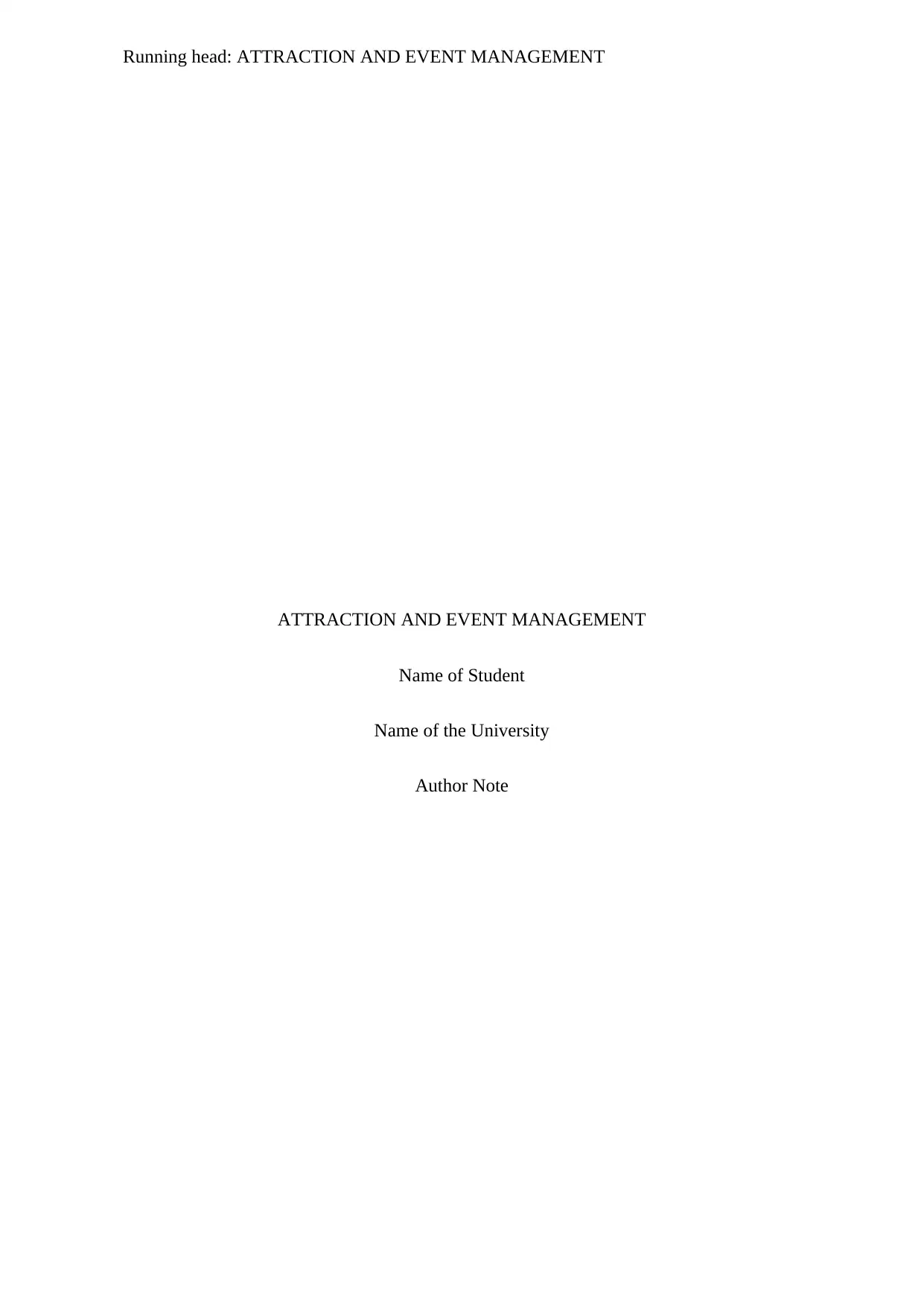
Running head: ATTRACTION AND EVENT MANAGEMENT
ATTRACTION AND EVENT MANAGEMENT
Name of Student
Name of the University
Author Note
ATTRACTION AND EVENT MANAGEMENT
Name of Student
Name of the University
Author Note
Paraphrase This Document
Need a fresh take? Get an instant paraphrase of this document with our AI Paraphraser
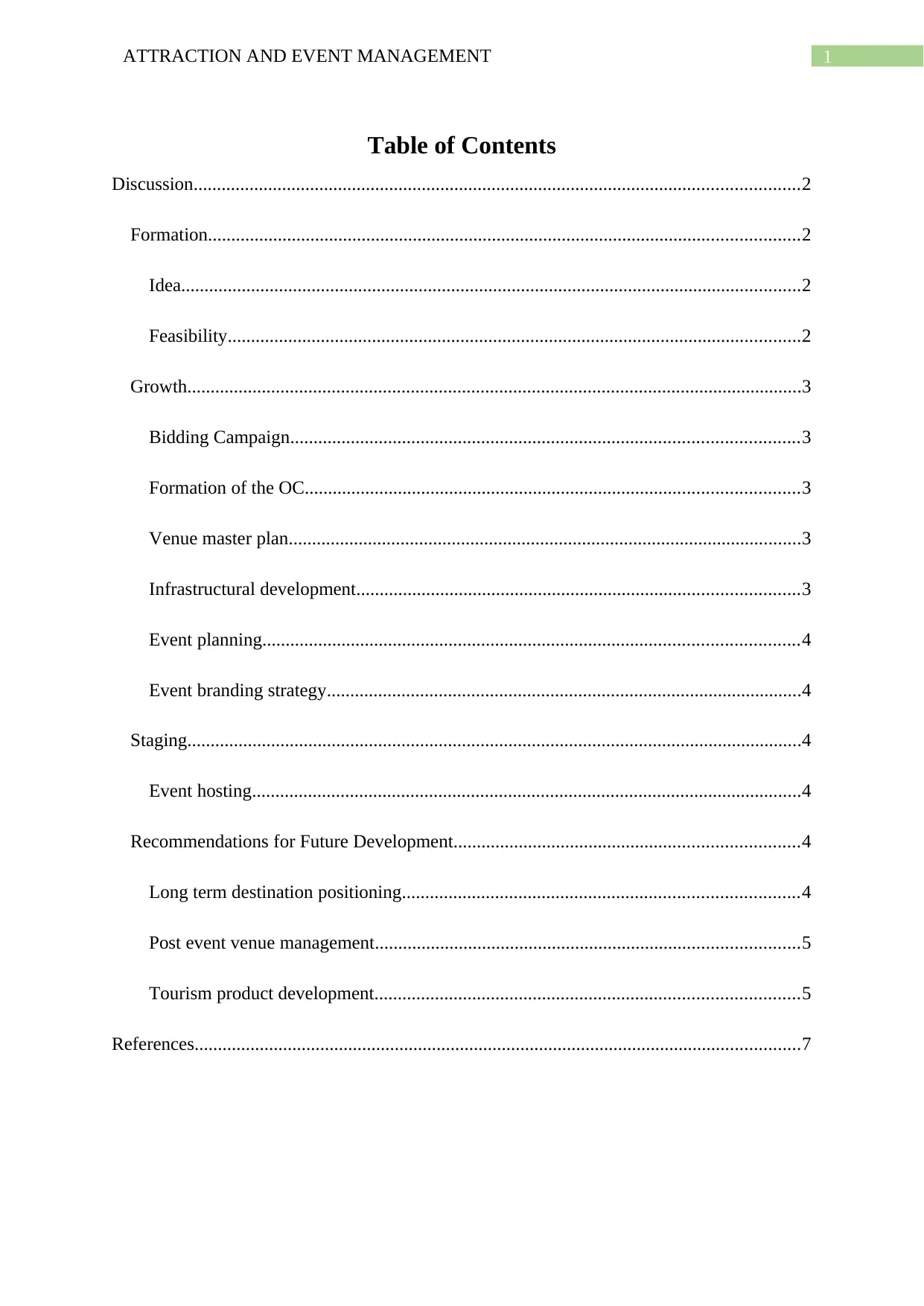
1ATTRACTION AND EVENT MANAGEMENT
Table of Contents
Discussion..................................................................................................................................2
Formation...............................................................................................................................2
Idea.....................................................................................................................................2
Feasibility...........................................................................................................................2
Growth....................................................................................................................................3
Bidding Campaign.............................................................................................................3
Formation of the OC..........................................................................................................3
Venue master plan..............................................................................................................3
Infrastructural development...............................................................................................3
Event planning...................................................................................................................4
Event branding strategy......................................................................................................4
Staging....................................................................................................................................4
Event hosting......................................................................................................................4
Recommendations for Future Development..........................................................................4
Long term destination positioning.....................................................................................4
Post event venue management...........................................................................................5
Tourism product development...........................................................................................5
References..................................................................................................................................7
Table of Contents
Discussion..................................................................................................................................2
Formation...............................................................................................................................2
Idea.....................................................................................................................................2
Feasibility...........................................................................................................................2
Growth....................................................................................................................................3
Bidding Campaign.............................................................................................................3
Formation of the OC..........................................................................................................3
Venue master plan..............................................................................................................3
Infrastructural development...............................................................................................3
Event planning...................................................................................................................4
Event branding strategy......................................................................................................4
Staging....................................................................................................................................4
Event hosting......................................................................................................................4
Recommendations for Future Development..........................................................................4
Long term destination positioning.....................................................................................4
Post event venue management...........................................................................................5
Tourism product development...........................................................................................5
References..................................................................................................................................7
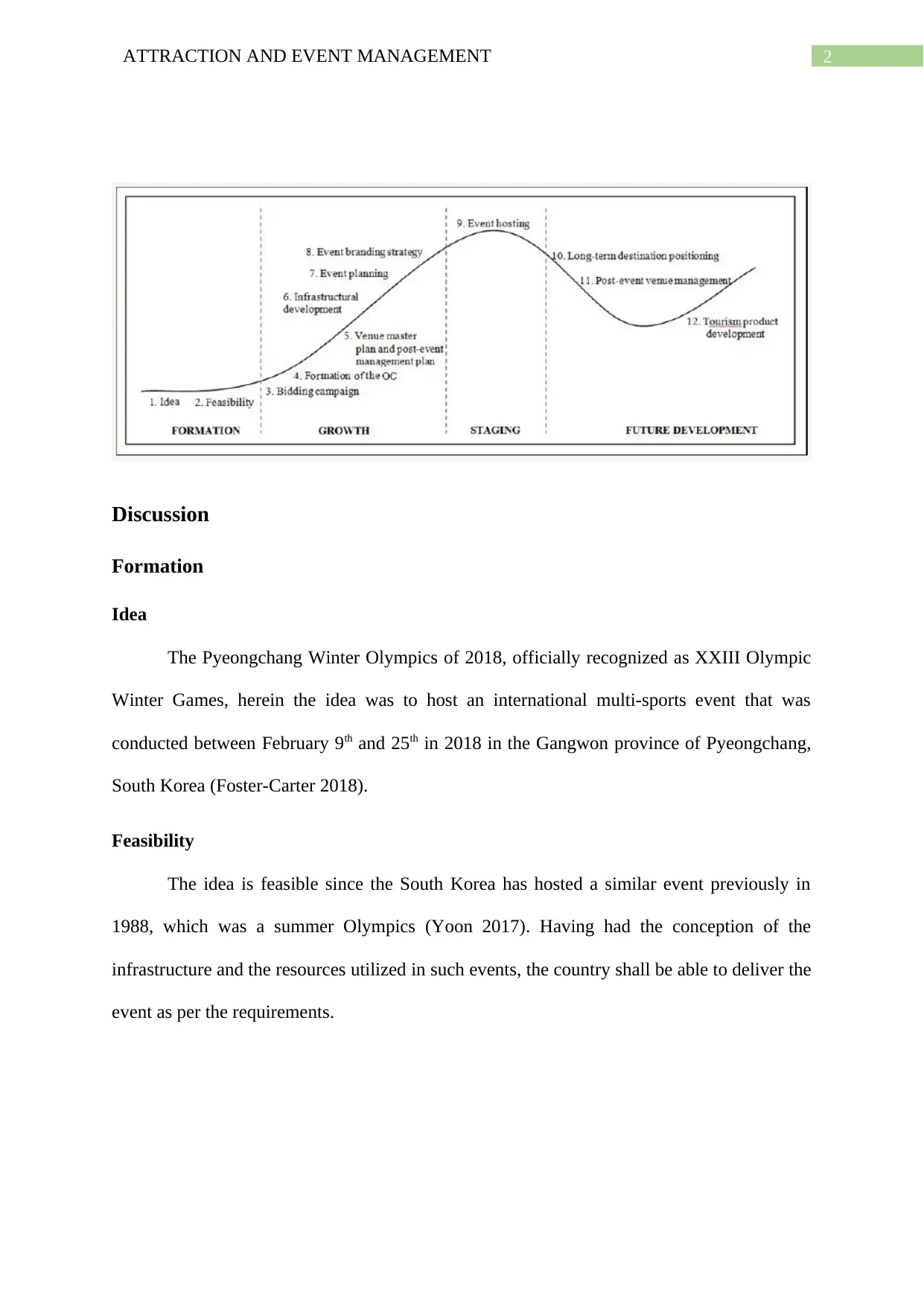
2ATTRACTION AND EVENT MANAGEMENT
Discussion
Formation
Idea
The Pyeongchang Winter Olympics of 2018, officially recognized as XXIII Olympic
Winter Games, herein the idea was to host an international multi-sports event that was
conducted between February 9th and 25th in 2018 in the Gangwon province of Pyeongchang,
South Korea (Foster-Carter 2018).
Feasibility
The idea is feasible since the South Korea has hosted a similar event previously in
1988, which was a summer Olympics (Yoon 2017). Having had the conception of the
infrastructure and the resources utilized in such events, the country shall be able to deliver the
event as per the requirements.
Discussion
Formation
Idea
The Pyeongchang Winter Olympics of 2018, officially recognized as XXIII Olympic
Winter Games, herein the idea was to host an international multi-sports event that was
conducted between February 9th and 25th in 2018 in the Gangwon province of Pyeongchang,
South Korea (Foster-Carter 2018).
Feasibility
The idea is feasible since the South Korea has hosted a similar event previously in
1988, which was a summer Olympics (Yoon 2017). Having had the conception of the
infrastructure and the resources utilized in such events, the country shall be able to deliver the
event as per the requirements.
⊘ This is a preview!⊘
Do you want full access?
Subscribe today to unlock all pages.

Trusted by 1+ million students worldwide
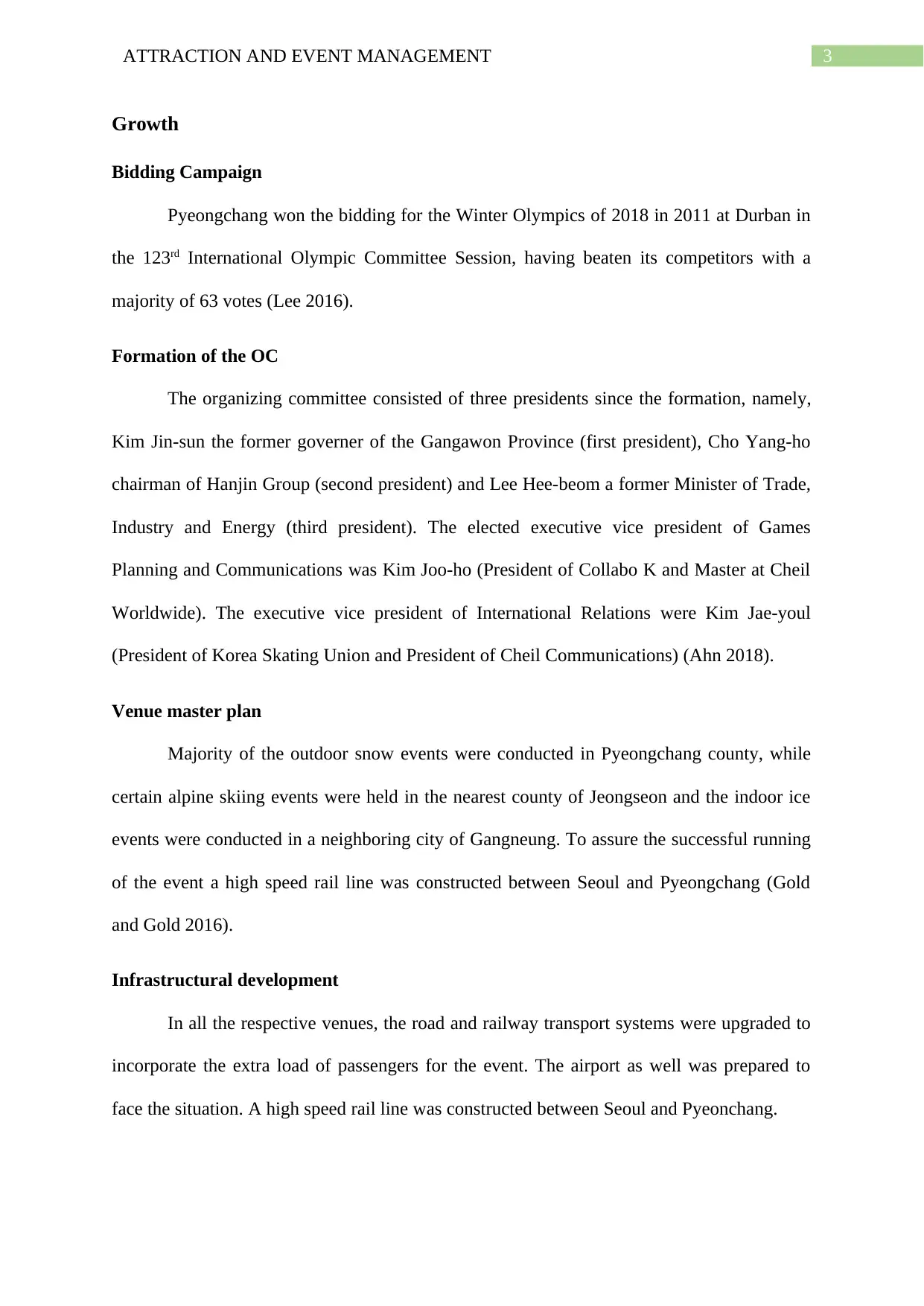
3ATTRACTION AND EVENT MANAGEMENT
Growth
Bidding Campaign
Pyeongchang won the bidding for the Winter Olympics of 2018 in 2011 at Durban in
the 123rd International Olympic Committee Session, having beaten its competitors with a
majority of 63 votes (Lee 2016).
Formation of the OC
The organizing committee consisted of three presidents since the formation, namely,
Kim Jin-sun the former governer of the Gangawon Province (first president), Cho Yang-ho
chairman of Hanjin Group (second president) and Lee Hee-beom a former Minister of Trade,
Industry and Energy (third president). The elected executive vice president of Games
Planning and Communications was Kim Joo-ho (President of Collabo K and Master at Cheil
Worldwide). The executive vice president of International Relations were Kim Jae-youl
(President of Korea Skating Union and President of Cheil Communications) (Ahn 2018).
Venue master plan
Majority of the outdoor snow events were conducted in Pyeongchang county, while
certain alpine skiing events were held in the nearest county of Jeongseon and the indoor ice
events were conducted in a neighboring city of Gangneung. To assure the successful running
of the event a high speed rail line was constructed between Seoul and Pyeongchang (Gold
and Gold 2016).
Infrastructural development
In all the respective venues, the road and railway transport systems were upgraded to
incorporate the extra load of passengers for the event. The airport as well was prepared to
face the situation. A high speed rail line was constructed between Seoul and Pyeonchang.
Growth
Bidding Campaign
Pyeongchang won the bidding for the Winter Olympics of 2018 in 2011 at Durban in
the 123rd International Olympic Committee Session, having beaten its competitors with a
majority of 63 votes (Lee 2016).
Formation of the OC
The organizing committee consisted of three presidents since the formation, namely,
Kim Jin-sun the former governer of the Gangawon Province (first president), Cho Yang-ho
chairman of Hanjin Group (second president) and Lee Hee-beom a former Minister of Trade,
Industry and Energy (third president). The elected executive vice president of Games
Planning and Communications was Kim Joo-ho (President of Collabo K and Master at Cheil
Worldwide). The executive vice president of International Relations were Kim Jae-youl
(President of Korea Skating Union and President of Cheil Communications) (Ahn 2018).
Venue master plan
Majority of the outdoor snow events were conducted in Pyeongchang county, while
certain alpine skiing events were held in the nearest county of Jeongseon and the indoor ice
events were conducted in a neighboring city of Gangneung. To assure the successful running
of the event a high speed rail line was constructed between Seoul and Pyeongchang (Gold
and Gold 2016).
Infrastructural development
In all the respective venues, the road and railway transport systems were upgraded to
incorporate the extra load of passengers for the event. The airport as well was prepared to
face the situation. A high speed rail line was constructed between Seoul and Pyeonchang.
Paraphrase This Document
Need a fresh take? Get an instant paraphrase of this document with our AI Paraphraser
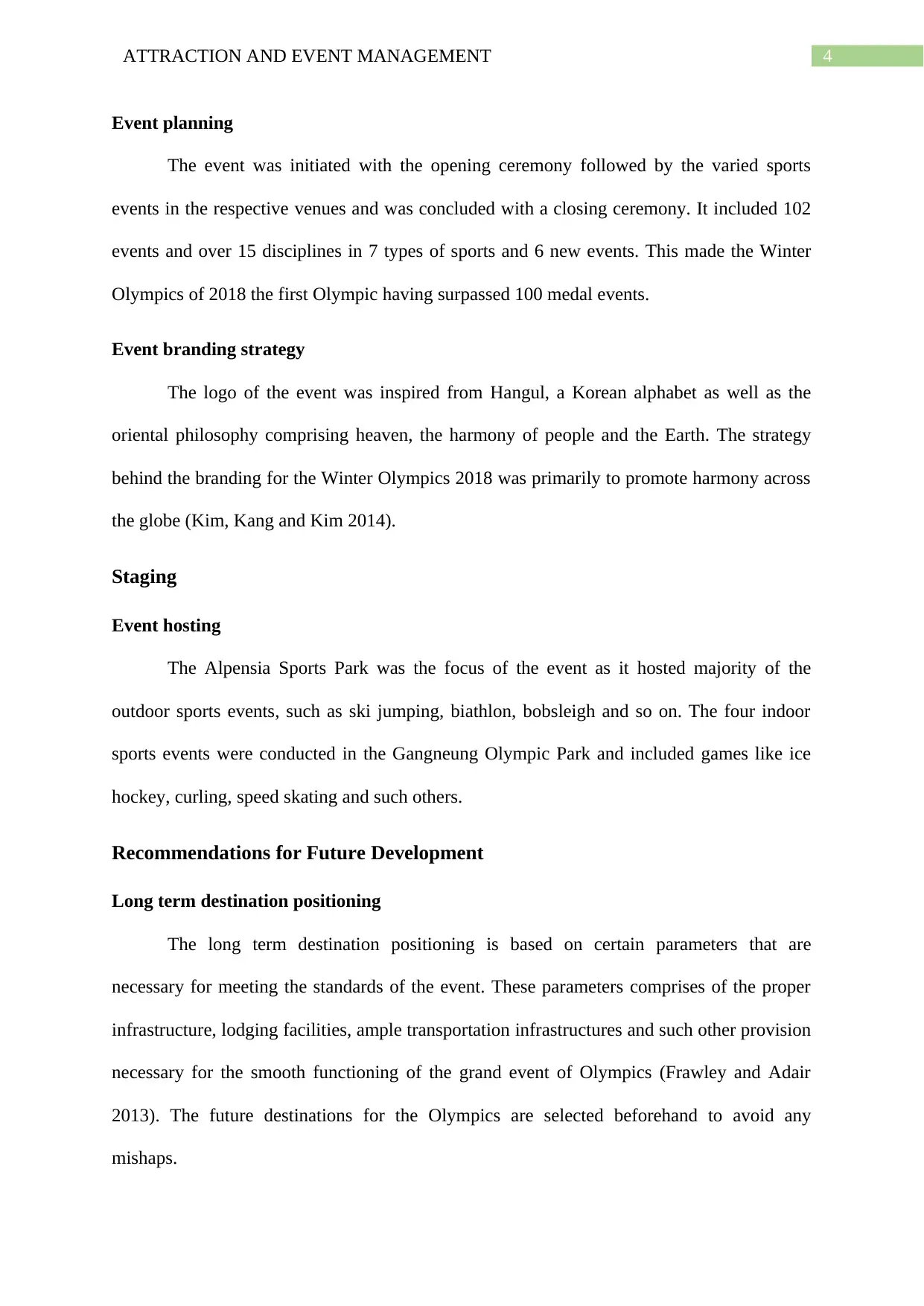
4ATTRACTION AND EVENT MANAGEMENT
Event planning
The event was initiated with the opening ceremony followed by the varied sports
events in the respective venues and was concluded with a closing ceremony. It included 102
events and over 15 disciplines in 7 types of sports and 6 new events. This made the Winter
Olympics of 2018 the first Olympic having surpassed 100 medal events.
Event branding strategy
The logo of the event was inspired from Hangul, a Korean alphabet as well as the
oriental philosophy comprising heaven, the harmony of people and the Earth. The strategy
behind the branding for the Winter Olympics 2018 was primarily to promote harmony across
the globe (Kim, Kang and Kim 2014).
Staging
Event hosting
The Alpensia Sports Park was the focus of the event as it hosted majority of the
outdoor sports events, such as ski jumping, biathlon, bobsleigh and so on. The four indoor
sports events were conducted in the Gangneung Olympic Park and included games like ice
hockey, curling, speed skating and such others.
Recommendations for Future Development
Long term destination positioning
The long term destination positioning is based on certain parameters that are
necessary for meeting the standards of the event. These parameters comprises of the proper
infrastructure, lodging facilities, ample transportation infrastructures and such other provision
necessary for the smooth functioning of the grand event of Olympics (Frawley and Adair
2013). The future destinations for the Olympics are selected beforehand to avoid any
mishaps.
Event planning
The event was initiated with the opening ceremony followed by the varied sports
events in the respective venues and was concluded with a closing ceremony. It included 102
events and over 15 disciplines in 7 types of sports and 6 new events. This made the Winter
Olympics of 2018 the first Olympic having surpassed 100 medal events.
Event branding strategy
The logo of the event was inspired from Hangul, a Korean alphabet as well as the
oriental philosophy comprising heaven, the harmony of people and the Earth. The strategy
behind the branding for the Winter Olympics 2018 was primarily to promote harmony across
the globe (Kim, Kang and Kim 2014).
Staging
Event hosting
The Alpensia Sports Park was the focus of the event as it hosted majority of the
outdoor sports events, such as ski jumping, biathlon, bobsleigh and so on. The four indoor
sports events were conducted in the Gangneung Olympic Park and included games like ice
hockey, curling, speed skating and such others.
Recommendations for Future Development
Long term destination positioning
The long term destination positioning is based on certain parameters that are
necessary for meeting the standards of the event. These parameters comprises of the proper
infrastructure, lodging facilities, ample transportation infrastructures and such other provision
necessary for the smooth functioning of the grand event of Olympics (Frawley and Adair
2013). The future destinations for the Olympics are selected beforehand to avoid any
mishaps.
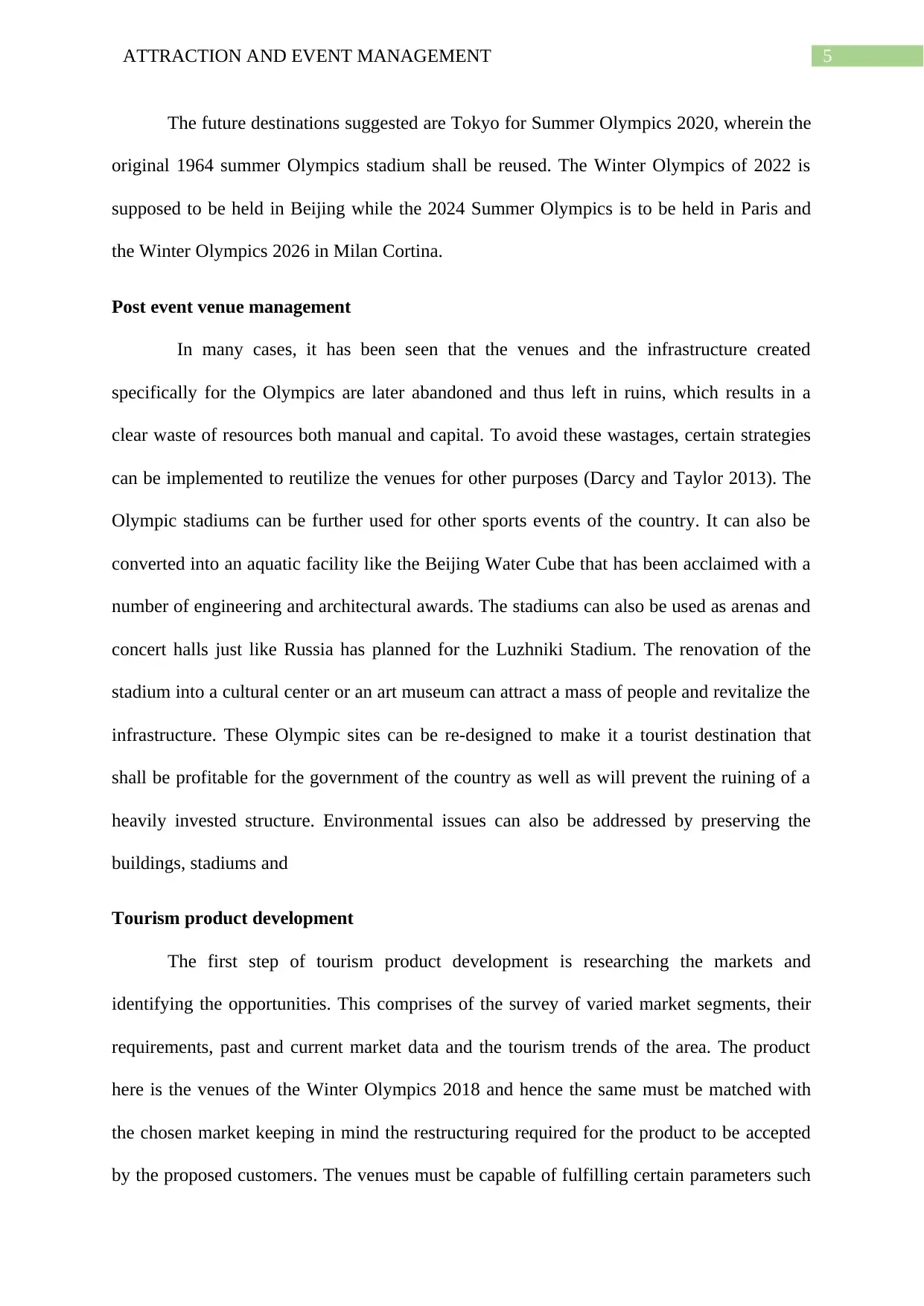
5ATTRACTION AND EVENT MANAGEMENT
The future destinations suggested are Tokyo for Summer Olympics 2020, wherein the
original 1964 summer Olympics stadium shall be reused. The Winter Olympics of 2022 is
supposed to be held in Beijing while the 2024 Summer Olympics is to be held in Paris and
the Winter Olympics 2026 in Milan Cortina.
Post event venue management
In many cases, it has been seen that the venues and the infrastructure created
specifically for the Olympics are later abandoned and thus left in ruins, which results in a
clear waste of resources both manual and capital. To avoid these wastages, certain strategies
can be implemented to reutilize the venues for other purposes (Darcy and Taylor 2013). The
Olympic stadiums can be further used for other sports events of the country. It can also be
converted into an aquatic facility like the Beijing Water Cube that has been acclaimed with a
number of engineering and architectural awards. The stadiums can also be used as arenas and
concert halls just like Russia has planned for the Luzhniki Stadium. The renovation of the
stadium into a cultural center or an art museum can attract a mass of people and revitalize the
infrastructure. These Olympic sites can be re-designed to make it a tourist destination that
shall be profitable for the government of the country as well as will prevent the ruining of a
heavily invested structure. Environmental issues can also be addressed by preserving the
buildings, stadiums and
Tourism product development
The first step of tourism product development is researching the markets and
identifying the opportunities. This comprises of the survey of varied market segments, their
requirements, past and current market data and the tourism trends of the area. The product
here is the venues of the Winter Olympics 2018 and hence the same must be matched with
the chosen market keeping in mind the restructuring required for the product to be accepted
by the proposed customers. The venues must be capable of fulfilling certain parameters such
The future destinations suggested are Tokyo for Summer Olympics 2020, wherein the
original 1964 summer Olympics stadium shall be reused. The Winter Olympics of 2022 is
supposed to be held in Beijing while the 2024 Summer Olympics is to be held in Paris and
the Winter Olympics 2026 in Milan Cortina.
Post event venue management
In many cases, it has been seen that the venues and the infrastructure created
specifically for the Olympics are later abandoned and thus left in ruins, which results in a
clear waste of resources both manual and capital. To avoid these wastages, certain strategies
can be implemented to reutilize the venues for other purposes (Darcy and Taylor 2013). The
Olympic stadiums can be further used for other sports events of the country. It can also be
converted into an aquatic facility like the Beijing Water Cube that has been acclaimed with a
number of engineering and architectural awards. The stadiums can also be used as arenas and
concert halls just like Russia has planned for the Luzhniki Stadium. The renovation of the
stadium into a cultural center or an art museum can attract a mass of people and revitalize the
infrastructure. These Olympic sites can be re-designed to make it a tourist destination that
shall be profitable for the government of the country as well as will prevent the ruining of a
heavily invested structure. Environmental issues can also be addressed by preserving the
buildings, stadiums and
Tourism product development
The first step of tourism product development is researching the markets and
identifying the opportunities. This comprises of the survey of varied market segments, their
requirements, past and current market data and the tourism trends of the area. The product
here is the venues of the Winter Olympics 2018 and hence the same must be matched with
the chosen market keeping in mind the restructuring required for the product to be accepted
by the proposed customers. The venues must be capable of fulfilling certain parameters such
⊘ This is a preview!⊘
Do you want full access?
Subscribe today to unlock all pages.

Trusted by 1+ million students worldwide
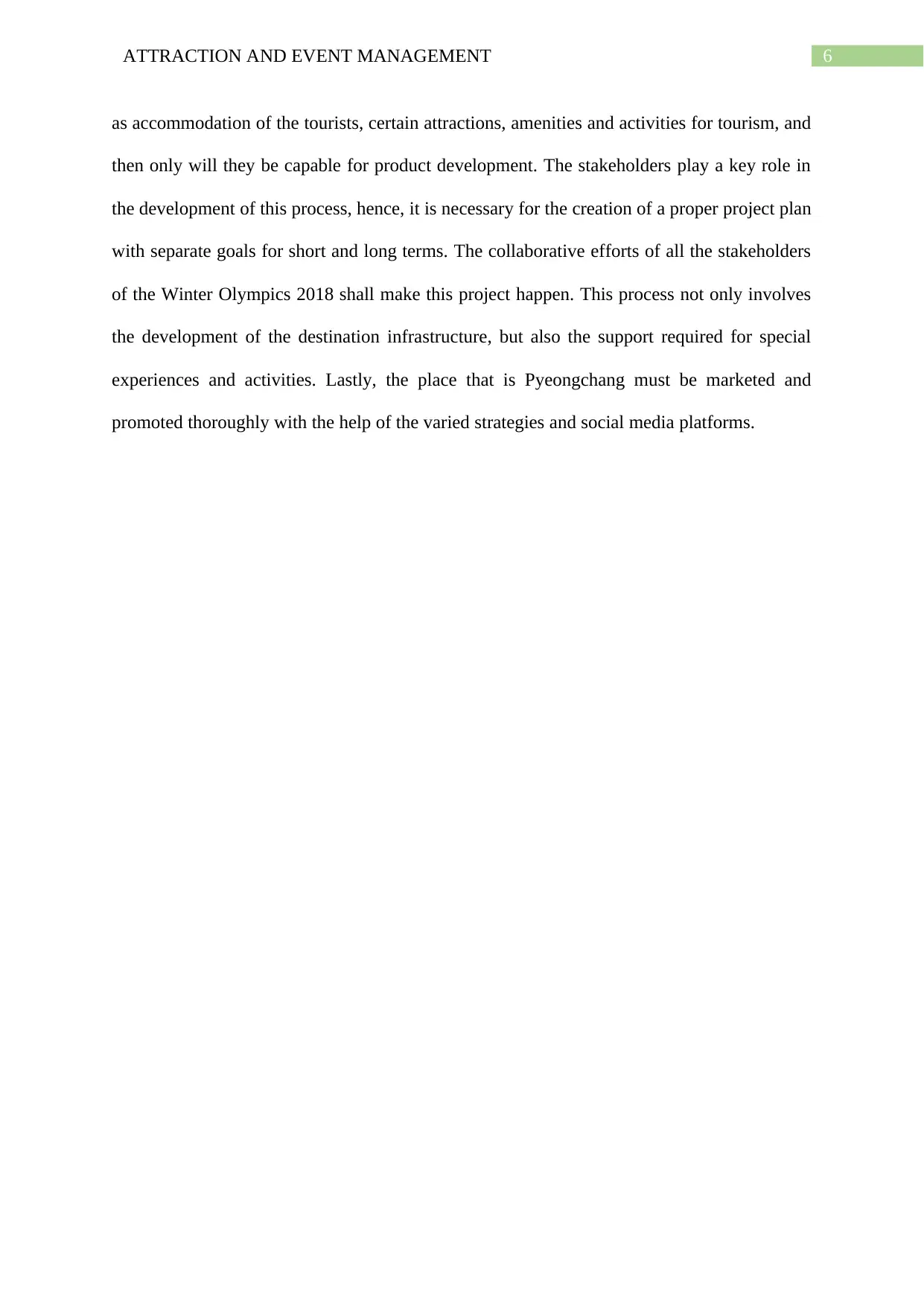
6ATTRACTION AND EVENT MANAGEMENT
as accommodation of the tourists, certain attractions, amenities and activities for tourism, and
then only will they be capable for product development. The stakeholders play a key role in
the development of this process, hence, it is necessary for the creation of a proper project plan
with separate goals for short and long terms. The collaborative efforts of all the stakeholders
of the Winter Olympics 2018 shall make this project happen. This process not only involves
the development of the destination infrastructure, but also the support required for special
experiences and activities. Lastly, the place that is Pyeongchang must be marketed and
promoted thoroughly with the help of the varied strategies and social media platforms.
as accommodation of the tourists, certain attractions, amenities and activities for tourism, and
then only will they be capable for product development. The stakeholders play a key role in
the development of this process, hence, it is necessary for the creation of a proper project plan
with separate goals for short and long terms. The collaborative efforts of all the stakeholders
of the Winter Olympics 2018 shall make this project happen. This process not only involves
the development of the destination infrastructure, but also the support required for special
experiences and activities. Lastly, the place that is Pyeongchang must be marketed and
promoted thoroughly with the help of the varied strategies and social media platforms.
Paraphrase This Document
Need a fresh take? Get an instant paraphrase of this document with our AI Paraphraser
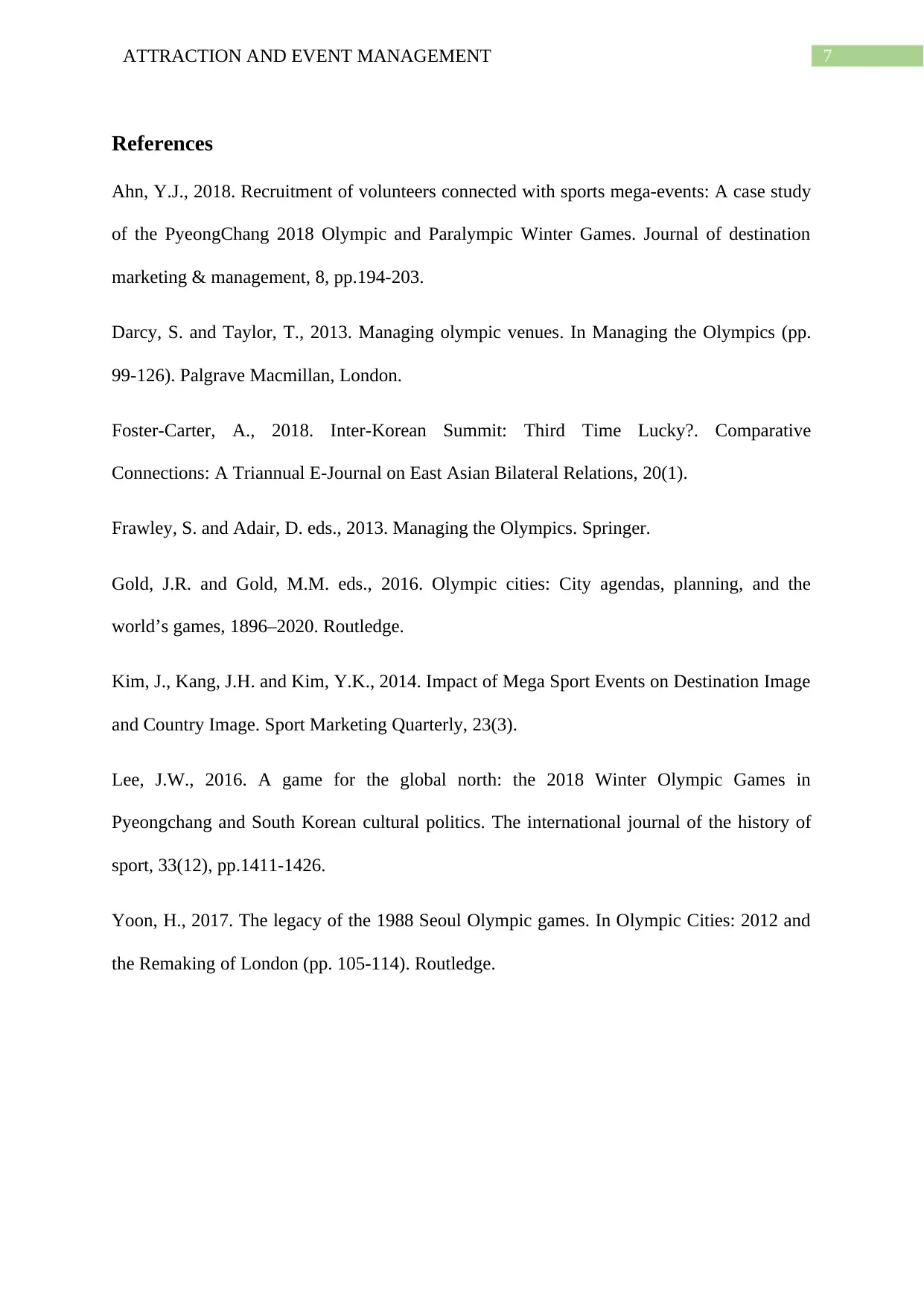
7ATTRACTION AND EVENT MANAGEMENT
References
Ahn, Y.J., 2018. Recruitment of volunteers connected with sports mega-events: A case study
of the PyeongChang 2018 Olympic and Paralympic Winter Games. Journal of destination
marketing & management, 8, pp.194-203.
Darcy, S. and Taylor, T., 2013. Managing olympic venues. In Managing the Olympics (pp.
99-126). Palgrave Macmillan, London.
Foster-Carter, A., 2018. Inter-Korean Summit: Third Time Lucky?. Comparative
Connections: A Triannual E-Journal on East Asian Bilateral Relations, 20(1).
Frawley, S. and Adair, D. eds., 2013. Managing the Olympics. Springer.
Gold, J.R. and Gold, M.M. eds., 2016. Olympic cities: City agendas, planning, and the
world’s games, 1896–2020. Routledge.
Kim, J., Kang, J.H. and Kim, Y.K., 2014. Impact of Mega Sport Events on Destination Image
and Country Image. Sport Marketing Quarterly, 23(3).
Lee, J.W., 2016. A game for the global north: the 2018 Winter Olympic Games in
Pyeongchang and South Korean cultural politics. The international journal of the history of
sport, 33(12), pp.1411-1426.
Yoon, H., 2017. The legacy of the 1988 Seoul Olympic games. In Olympic Cities: 2012 and
the Remaking of London (pp. 105-114). Routledge.
References
Ahn, Y.J., 2018. Recruitment of volunteers connected with sports mega-events: A case study
of the PyeongChang 2018 Olympic and Paralympic Winter Games. Journal of destination
marketing & management, 8, pp.194-203.
Darcy, S. and Taylor, T., 2013. Managing olympic venues. In Managing the Olympics (pp.
99-126). Palgrave Macmillan, London.
Foster-Carter, A., 2018. Inter-Korean Summit: Third Time Lucky?. Comparative
Connections: A Triannual E-Journal on East Asian Bilateral Relations, 20(1).
Frawley, S. and Adair, D. eds., 2013. Managing the Olympics. Springer.
Gold, J.R. and Gold, M.M. eds., 2016. Olympic cities: City agendas, planning, and the
world’s games, 1896–2020. Routledge.
Kim, J., Kang, J.H. and Kim, Y.K., 2014. Impact of Mega Sport Events on Destination Image
and Country Image. Sport Marketing Quarterly, 23(3).
Lee, J.W., 2016. A game for the global north: the 2018 Winter Olympic Games in
Pyeongchang and South Korean cultural politics. The international journal of the history of
sport, 33(12), pp.1411-1426.
Yoon, H., 2017. The legacy of the 1988 Seoul Olympic games. In Olympic Cities: 2012 and
the Remaking of London (pp. 105-114). Routledge.
1 out of 8
Related Documents
Your All-in-One AI-Powered Toolkit for Academic Success.
+13062052269
info@desklib.com
Available 24*7 on WhatsApp / Email
![[object Object]](/_next/static/media/star-bottom.7253800d.svg)
Unlock your academic potential
Copyright © 2020–2025 A2Z Services. All Rights Reserved. Developed and managed by ZUCOL.





